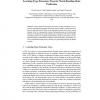103 search results - page 15 / 21 » Learning recursive functions: A survey |
CORR
2010
Springer
13 years 6 months ago
2010
Springer
We propose a new approach to value function approximation which combines linear temporal difference reinforcement learning with subspace identification. In practical applications...
KI
2008
Springer
13 years 7 months ago
2008
Springer
Abstract. In this paper we present a comparison of several inductive programming (IP) systems. IP addresses the problem of learning (recursive) programs from incomplete specificati...
ML
2011
ACM
13 years 1 months ago
2011
ACM
Abstract. Type Extension Trees (TET) have been recently introduced as an expressive representation language allowing to encode complex combinatorial features of relational entities...
ACII
2007
Springer
14 years 1 months ago
2007
Springer
An investigation into capturing the relation of physiology, beyond heart rate recording, to expressed preferences of entertainment in children’s physical gameplay is presented in...
BMCBI
2004
13 years 7 months ago
2004
Background: In addition to known protein-coding genes, large amounts of apparently non-coding sequence are conserved between the human and mouse genomes. It seems reasonable to as...

